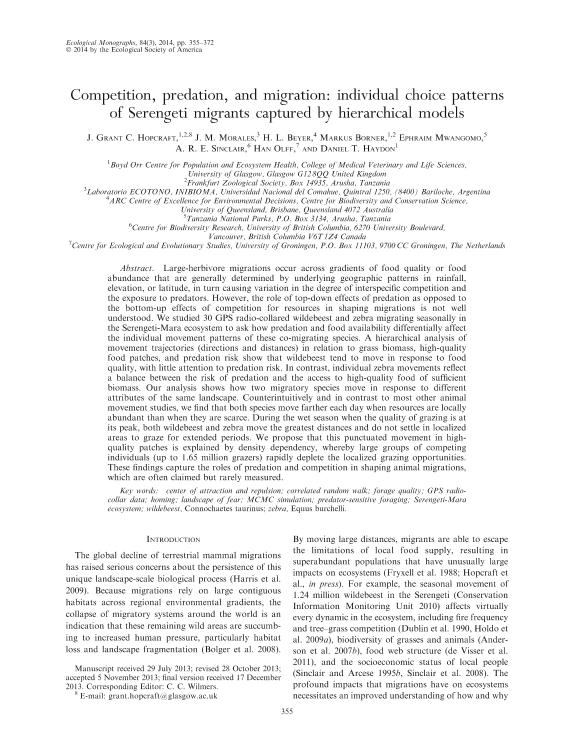Mostrar el registro sencillo del ítem
dc.contributor.author
Hopcraft, J. Grant
dc.contributor.author
Morales, Juan Manuel

dc.contributor.author
Beyer, H. L.
dc.contributor.author
Borner, Markus
dc.contributor.author
Mwangomo, Ephraim
dc.contributor.author
Sinclair, A. R. E.
dc.contributor.author
Olff, Han
dc.contributor.author
Haydon, Daniel T.
dc.date.available
2017-01-24T18:02:57Z
dc.date.issued
2014-06
dc.identifier.citation
Hopcraft, J. Grant; Morales, Juan Manuel; Beyer, H. L.; Borner, Markus; Mwangomo, Ephraim; et al.; Competition, predation and migration: Individual choice patterns of Serengeti migrants captured by hierarchical models; Ecological Society Of America; Ecological Monographs; 84; 3; 6-2014; 355-372
dc.identifier.issn
0012-9615
dc.identifier.uri
http://hdl.handle.net/11336/11819
dc.description.abstract
Large-herbivore migrations occur across gradients of food quality or food abundance that are generally determined by underlying geographic patterns in rainfall, elevation, or latitude, in turn causing variation in the degree of interspecific competition and the exposure to predators. However, the role of top-down effects of predation as opposed to the bottom-up effects of competition for resources in shaping migrations is not well understood. We studied 30 GPS radio-collared wildebeest and zebra migrating seasonally in the Serengeti-Mara ecosystem to ask how predation and food availability differentially affect the individual movement patterns of these co-migrating species. A hierarchical analysis of movement trajectories (directions and distances) in relation to grass biomass, high-quality food patches, and predation risk show that wildebeest tend to move in response to food quality, with little attention to predation risk. In contrast, individual zebra movements reflect a balance between the risk of predation and the access to high-quality food of sufficient biomass. Our analysis shows how two migratory species move in response to different attributes of the same landscape. Counterintuitively and in contrast to most other animal movement studies, we find that both species move farther each day when resources are locally abundant than when they are scarce. During the wet season when the quality of grazing is at its peak, both wildebeest and zebra move the greatest distances and do not settle in localized areas to graze for extended periods. We propose that this punctuated movement in high- quality patches is explained by density dependency, whereby large groups of competing individuals (up to 1.65 million grazers) rapidly deplete the localized grazing opportunities. These findings capture the roles of predation and competition in shaping animal migrations, which are often claimed but rarely measured.
dc.format
application/pdf
dc.language.iso
eng
dc.publisher
Ecological Society Of America

dc.rights
info:eu-repo/semantics/openAccess
dc.rights.uri
https://creativecommons.org/licenses/by-nc-sa/2.5/ar/
dc.subject
Center of Attraction And Repulsion
dc.subject
Correlated Random Walk
dc.subject
Forage Quality
dc.subject
Gps
dc.subject.classification
Ecología

dc.subject.classification
Ciencias Biológicas

dc.subject.classification
CIENCIAS NATURALES Y EXACTAS

dc.title
Competition, predation and migration: Individual choice patterns of Serengeti migrants captured by hierarchical models
dc.type
info:eu-repo/semantics/article
dc.type
info:ar-repo/semantics/artículo
dc.type
info:eu-repo/semantics/publishedVersion
dc.date.updated
2016-12-12T14:21:15Z
dc.journal.volume
84
dc.journal.number
3
dc.journal.pagination
355-372
dc.journal.pais
Estados Unidos

dc.journal.ciudad
Nueva York
dc.description.fil
Fil: Hopcraft, J. Grant. University Of Glasgow; Reino Unido. Frankfurt Zoological Society; Tanzania
dc.description.fil
Fil: Morales, Juan Manuel. Universidad Nacional del Comahue. Centro Regional Universitario Bariloche. Laboratorio de Ecotono; Argentina. Consejo Nacional de Investigaciones Científicas y Técnicas. Centro Científico Tecnológico Patagonia Norte. Instituto de Investigación en Biodiversidad y Medioambiente; Argentina
dc.description.fil
Fil: Beyer, H. L.. The University Of Queensland; Australia
dc.description.fil
Fil: Borner, Markus. University Of Glasgow; Reino Unido. Frankfurt Zoological Society; Tanzania
dc.description.fil
Fil: Mwangomo, Ephraim. Tanzania National Parks; Tanzania
dc.description.fil
Fil: Sinclair, A. R. E.. University Of British Columbia; Canadá
dc.description.fil
Fil: Olff, Han. University Of Groningen; Países Bajos
dc.description.fil
Fil: Haydon, Daniel T.. University Of Glasgow; Reino Unido
dc.journal.title
Ecological Monographs

dc.relation.alternativeid
info:eu-repo/semantics/altIdentifier/url/http://onlinelibrary.wiley.com/doi/10.1890/13-1446.1/abstract
dc.relation.alternativeid
info:eu-repo/semantics/altIdentifier/doi/http://dx.doi.org/10.1890/13-1446.1
Archivos asociados
